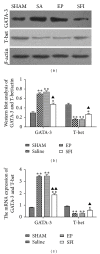Effects of Shen-Fu Injection on the Expression of T-Cell-Specific Transcription Factors T-bet/Gata-3 in Porcine Postresuscitation Lung Injury
- PMID: 23573129
- PMCID: PMC3610339
- DOI: 10.1155/2013/464650
Effects of Shen-Fu Injection on the Expression of T-Cell-Specific Transcription Factors T-bet/Gata-3 in Porcine Postresuscitation Lung Injury
Abstract
Shen-Fu injection (SFI) derived from the ancient traditional Chinese medicine. In this study, the effects of SFI on the expression of T-bet/GATA-3 and its potential mechanisms causing the shift of T cells from Th2 to Th1 on postresuscitation lung injury were examined in a porcine model of cardiac arrest. 30 pigs were randomly divided into SHAM (n = 6) and three return of spontaneous circulation (ROSC) groups (n = 8 per group); 24 pigs were subjected to 8 min of electrically induced cardiac arrest and 2 min of basic life support, which received central venous injection of Shen-Fu (SFI), epinephrine (EP) or saline (SA). After successful ROSC, 18 surviving pigs were sacrificed at 24 h after ROSC (n = 6 per group). The levels of serum and lung tissue interleukin (IL)-4 and interferon (IFN)- γ were measured by ELISA, and the protein and mRNA levels of GATA-3 and T-bet in the lung tissue were determined by western blotting and quantitative real-time polymerase chain reaction, respectively. Compared with the EP and SA groups, SFI treatment reduced the levels of IL-4 (P < 0.05), increased levels of IFN- γ (P < 0.05), and induced T-bet mRNA upregulation and GATA-3 mRNA downregulation (P < 0.05). SFI attenuated lung injury and regulated lung immune disorders. Therefore, SFI could protect postresuscitation lung injury by modulating a Th1/Th2 imbalance.
Figures



Similar articles
-
Effects of Shen-Fu Injection () on apoptosis of regulatory T lymphocytes in spleen during post-resuscitation immune dysfunction in a porcine model of cardiac arrest.Chin J Integr Med. 2016 Sep;22(9):666-73. doi: 10.1007/s11655-016-2505-2. Epub 2016 Sep 11. Chin J Integr Med. 2016. PMID: 27614451
-
[Effects of Shenfu injection on the expression of transcription factors T-bet / GATA-3 in pigs with post-resuscitation myocardial dysfunction].Zhonghua Wei Zhong Bing Ji Jiu Yi Xue. 2015 Mar;27(3):190-6. doi: 10.3760/cma.j.issn.2095-4352.2015.03.007. Zhonghua Wei Zhong Bing Ji Jiu Yi Xue. 2015. PMID: 25757968 Chinese.
-
Shen-fu injection reduces postresuscitation myocardial dysfunction in a porcine model of cardiac arrest by modulating apoptosis.Shock. 2012 Aug;38(3):301-6. doi: 10.1097/SHK.0b013e31825f6632. Shock. 2012. PMID: 22683733
-
Expression imbalance of transcription factors GATA-3 and T-bet in post-resuscitation myocardial immune dysfunction in a porcine model of cardiac arrest.Resuscitation. 2013 Jun;84(6):848-53. doi: 10.1016/j.resuscitation.2012.11.023. Epub 2012 Nov 29. Resuscitation. 2013. PMID: 23200999
-
The roles of traditional chinese medicine: shen-fu injection on the postresuscitation care bundle.Evid Based Complement Alternat Med. 2013;2013:319092. doi: 10.1155/2013/319092. Epub 2013 Aug 28. Evid Based Complement Alternat Med. 2013. PMID: 24066009 Free PMC article. Review.
Cited by
-
Establishment of a swine model of traumatic cardiac arrest induced by haemorrhage and ventricular fibrillation.J Int Med Res. 2020 Jun;48(6):300060520931260. doi: 10.1177/0300060520931260. J Int Med Res. 2020. PMID: 32588703 Free PMC article.
-
Effects of Chinese medicine shen-fu injection on the expression of inflammatory cytokines and complements during post-resuscitation immune dysfunction in a porcine model.Chin J Integr Med. 2016 Feb;22(2):101-9. doi: 10.1007/s11655-014-1857-8. Epub 2014 Sep 24. Chin J Integr Med. 2016. PMID: 25253551
-
Effects of combination therapy with Shenfu Injection in critically ill patients with septic shock receiving mechanical ventilation: A multicentric, real-world study.Front Pharmacol. 2022 Nov 9;13:1041326. doi: 10.3389/fphar.2022.1041326. eCollection 2022. Front Pharmacol. 2022. PMID: 36438846 Free PMC article.
-
Effects of Shen-Fu Injection () on apoptosis of regulatory T lymphocytes in spleen during post-resuscitation immune dysfunction in a porcine model of cardiac arrest.Chin J Integr Med. 2016 Sep;22(9):666-73. doi: 10.1007/s11655-016-2505-2. Epub 2016 Sep 11. Chin J Integr Med. 2016. PMID: 27614451
-
Effects of Shenfu injection and its main components on the contraction of isolated rat thoracic aortic rings.PLoS One. 2013 Oct 30;8(10):e78026. doi: 10.1371/journal.pone.0078026. eCollection 2013. PLoS One. 2013. PMID: 24205074 Free PMC article.
References
-
- Karimova A, Pinsky DJ. The endothelial response to oxygen deprivation: biology and clinical implications. Intensive Care Medicine. 2001;27(1):19–31. - PubMed
-
- Schoemaker WC, Appel PL, Kram HB. Tissue oxygen debt as a determinant of lethal and nonlethal postoperative organ failure. Critical Care Medicine. 1988;16(11):1117–1120. - PubMed
-
- Schwartz MD, Repine JE, Abraham E. Xanthine oxidase-derired oxygen radicals increase lung cytokine expression in mice subjected to hemorrhagic shock. American Journal of Respiratory Cell and Molecular Biology. 1995;12:434–440. - PubMed
-
- Zhang MY, Ji XF, Wang S, Li CS. Shen-Fu injection attenuates postresuscitation lung injury in a porcine model of cardiac arrest. Resusciatation. 2012;83(9):1152–1158. - PubMed
LinkOut - more resources
Full Text Sources
Other Literature Sources

